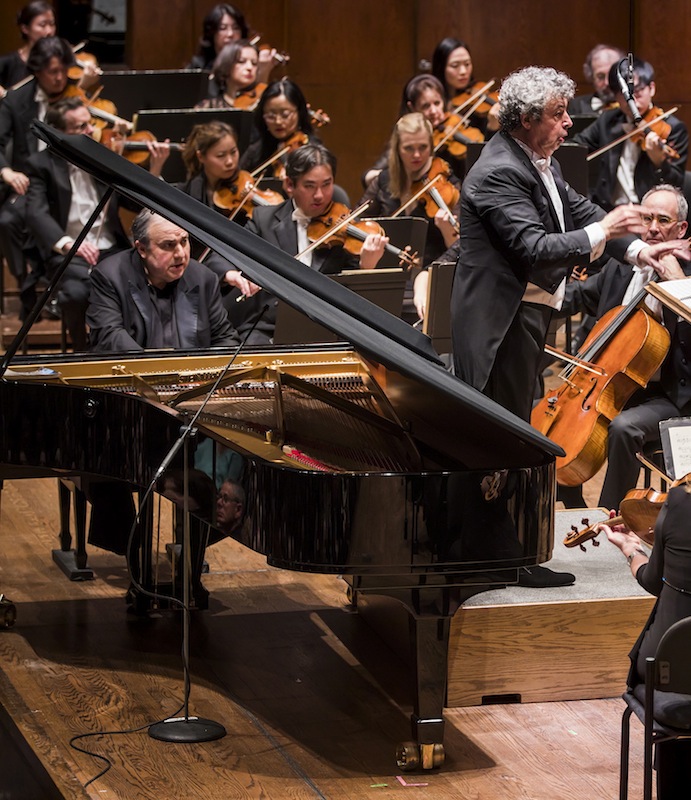Bychkov, Bronfman open Philharmonic’s Tchaikovsky festival with energy and eloquence

Yefim Bronfman performed Tchaikovsky’s Piano Concerto No. 2 with Semyon Bychkov and the New York Philharmonic Thursday night at David Geffen Hall. Photo: Chris Lee
Anton Bruckner is not the only composer presently taking up residence in New York concert halls.
Concurrent with the last third of the Staatskapelle Berlin’s Bruckner cycle at Carnegie Hall, the New York Philharmonic Thursday night launched their mid-season festival, “Beloved Friend — Tchaikovsky and His World,” before a large crowd at David Geffen Hall.
Semyon Bychkov was at the podium, and will be for the duration of the festival, which explores symphonic, chamber, and vocal music from Tchaikovsky and a select few other Russian composers. The central works on the opening program were the Piano Concerto No. 2, with Yefim Bronfman as soloist, and the Symphony No. 5.
The Philharmonic began the concert by skating through Glinka’s Valse-Fantasie. The playing was bright, and polite, the brief minor key passages dispatched with barely a hint of any troubled feelings inside. Stiff overall, but that’s why orchestra’s have warm-up pieces.
Bronfman was an excellent choice to interpret the Piano Concerto No. 2, which, depending on one’s point of view, can be thrilling or turgid. Looking from inside the 19th century, it’s the former, but the view from the 21st century can have one thinking the latter.
The concerto, played in its complete original version, comes from a place in history when the form began to trend towards the decadent. Almost gone were the sense of inner dialogue, and instead the emphasis was on (often spectacular) pianism, with the orchestra less as a partner than the audience for a lecture.
Yet Bronfman made it palatable. The physicality of his technique made things like the runs of chords, and the extended first movement cadenza, flow without exaggeration—he never indulged, but kept moving forward. And his clarity, certainty, and musical intelligence were a refreshing alternative to the self-glorification that the music demands.
Bronfman is also a fine ensemble player, and his self-effacement in the second movement, when a violin and cello join in to make for a bit of chamber music inside the concerto, was charming. More charming than the music itself—concertmaster Frank Huang and principal cellist Carter Brey played with sincerity, but Tchaikovsky’s lines walk a perilous balance between sentimentality and kitsch.
Much of the piano part is pure bashing, and Bronfman can bash with the best of them. Yet he did so with the determination to find something meaningful beyond sheer technique and force. The energized audience responded with loud cheers.
There were no such dangers in the elegant, musical reading of Symphony No. 5. This is a work that has gone in and out of favor ever since its premiere in 1888 (Tchaikovsky himself was disappointed with his ending and felt that it ruined the work), but with any given performance can still come off as the composer’s finest symphony.
The backbone is the famous march-like idea or “fate” theme. The motif appears in each movement, where it is transmuted by changing context, and variation, into an abstract accumulation and effects of experiences through time. So the march may be a fanfare, then a lament, depending on what has come before, a superb example of how structure and expressive narrative can work through the same notes.
The slow movement has a famous French horn solo, played wonderfully by Philip Myers. His classic, Old World sound and vibrato were an exceptional partner for the music, built out of complex memories of nostalgia and regret.
Bychkov, conducting from memory, guided the music with well-shaped dynamics and tempo modulations. Everything worked so well as to seem perfectly natural and logical, and overall he let the music flow and speak for itself, with not even a momentary indulgence in pathos. If anything, he reserved emphasis for the most strident moments, especially in the opening movement.
There, the volume of the brass swamped the orchestra. Bychkov kept highlighting the section through the performance, and the issue may have been insufficient volume in the strings and winds. As a section, the horns and low brass were excellent, crackling with life and sound. The rest of the orchestra rapidly caught up to their pace for a completely enjoyable and satisfying performance.
This program will be repeated 8 p.m. Friday and Saturday at David Geffen Hall. “Beloved Friend – Tchaikovsky and His World” continues through February 11. nyphil.org







Posted Jan 29, 2017 at 8:01 am by Alan M. Aron, M.D.
I found this concert nothing short of marvelous – absolutely
magnificent. What a wonderful experience.
Posted Feb 03, 2017 at 1:30 pm by Ianna Villanueva
Tchaikovsky music, as always, speaks of deep feelings, emotions, brilliant melodies, eloquent cadences, magnificent knowledge of classical, romantic and revolutionary music; the work of a genius. And Maestro Bychkov and pianist Bronfman gave monumental performances. A concert for the soul and the people who know enough to appreciate those jewels.